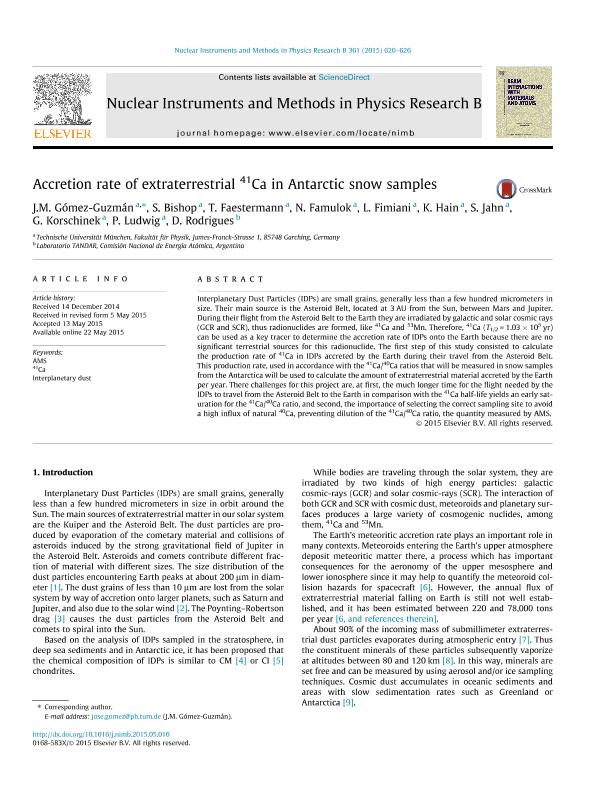Mostrar el registro sencillo del ítem
dc.contributor.author
Gómez Guzmán, J. M.
dc.contributor.author
Bishop, S.
dc.contributor.author
Faestermann, T.
dc.contributor.author
Famulok, N.
dc.contributor.author
Fimiani, Leticia

dc.contributor.author
Hain, K.
dc.contributor.author
Jahn, S.
dc.contributor.author
Korschinek, G.
dc.contributor.author
Ludwig, P.
dc.contributor.author
Rodrigues Ferreira Maltez, Dario Pablo

dc.date.available
2020-02-27T20:17:01Z
dc.date.issued
2015-10
dc.identifier.citation
Gómez Guzmán, J. M.; Bishop, S.; Faestermann, T.; Famulok, N.; Fimiani, Leticia; et al.; Accretion rate of extraterrestrial 41Ca in Antarctic snow samples; Elsevier Science; Beam Interactions with Materials and Atoms; 361; 10-2015; 620-626
dc.identifier.issn
0168-583X
dc.identifier.uri
http://hdl.handle.net/11336/98530
dc.description.abstract
Interplanetary Dust Particles (IDPs) are small grains, generally less than a few hundred micrometers in size. Their main source is the Asteroid Belt, located at 3 AU from the Sun, between Mars and Jupiter. During their flight from the Asteroid Belt to the Earth they are irradiated by galactic and solar cosmic rays (GCR and SCR), thus radionuclides are formed, like 41Ca and 53Mn. Therefore, 41Ca (T1/2 = 1.03 × 105 yr) can be used as a key tracer to determine the accretion rate of IDPs onto the Earth because there are no significant terrestrial sources for this radionuclide. The first step of this study consisted to calculate the production rate of 41Ca in IDPs accreted by the Earth during their travel from the Asteroid Belt. This production rate, used in accordance with the 41Ca/40Ca ratios that will be measured in snow samples from the Antarctica will be used to calculate the amount of extraterrestrial material accreted by the Earth per year. There challenges for this project are, at first, the much longer time for the flight needed by the IDPs to travel from the Asteroid Belt to the Earth in comparison with the 41Ca half-life yields an early saturation for the 41Ca/40Ca ratio, and second, the importance of selecting the correct sampling site to avoid a high influx of natural 40Ca, preventing dilution of the 41Ca/40Ca ratio, the quantity measured by AMS.
dc.format
application/pdf
dc.language.iso
eng
dc.publisher
Elsevier Science

dc.rights
info:eu-repo/semantics/openAccess
dc.rights.uri
https://creativecommons.org/licenses/by-nc-sa/2.5/ar/
dc.subject
41CA
dc.subject
AMS
dc.subject
INTERPLANETARY DUST
dc.subject.classification
Astronomía

dc.subject.classification
Ciencias Físicas

dc.subject.classification
CIENCIAS NATURALES Y EXACTAS

dc.title
Accretion rate of extraterrestrial 41Ca in Antarctic snow samples
dc.type
info:eu-repo/semantics/article
dc.type
info:ar-repo/semantics/artículo
dc.type
info:eu-repo/semantics/publishedVersion
dc.date.updated
2020-02-26T15:04:02Z
dc.journal.volume
361
dc.journal.pagination
620-626
dc.journal.pais
Países Bajos

dc.journal.ciudad
Amsterdam
dc.description.fil
Fil: Gómez Guzmán, J. M.. Technische Universitat München; Alemania
dc.description.fil
Fil: Bishop, S.. Technische Universitat München; Alemania
dc.description.fil
Fil: Faestermann, T.. Technische Universitat München; Alemania
dc.description.fil
Fil: Famulok, N.. Technische Universitat München; Alemania
dc.description.fil
Fil: Fimiani, Leticia. Technische Universitat München; Alemania
dc.description.fil
Fil: Hain, K.. Technische Universitat München; Alemania
dc.description.fil
Fil: Jahn, S.. Technische Universitat München; Alemania
dc.description.fil
Fil: Korschinek, G.. Technische Universitat München; Alemania
dc.description.fil
Fil: Ludwig, P.. Technische Universitat München; Alemania
dc.description.fil
Fil: Rodrigues Ferreira Maltez, Dario Pablo. Consejo Nacional de Investigaciones Científicas y Técnicas; Argentina. Comisión Nacional de Energía Atómica. Gerencia del Área de Investigación y Aplicaciones No Nucleares. Gerencia Física (Centro Atómico Constituyentes). Proyecto Tandar; Argentina
dc.journal.title
Beam Interactions with Materials and Atoms

dc.relation.alternativeid
info:eu-repo/semantics/altIdentifier/doi/http://dx.doi.org/10.1016/j.nimb.2015.05.016
dc.relation.alternativeid
info:eu-repo/semantics/altIdentifier/url/https://www.sciencedirect.com/science/article/pii/S0168583X15004875
Archivos asociados
